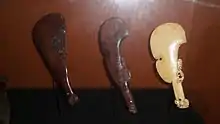Wahaika
A Wahaika is a type of traditional Māori hand weapon. Wahaika are short club-like weapons usually made of wood or whalebone and are used for thrusting and striking in close-quarter, hand-to-hand fighting.[1] Whalebone wahaika are called wahaika parāoa.[2]

Wahaika translates to "mouth of the fish",[3][4] in reference to the notch on one side which is used to catch an opponent's weapon. On the other side just above the handle the concave tip above a carved humanoid figure is the primary striking edge,[5] particularly used against the opponent's temples, face, and ribs.[3] The rest of the spherical edge is sharp like a blade.[2][6][7]
Wooden wahaika are often carved with intricate designs. In addition to being a fighting weapon, rangatira would hold wahaika during ceremonies and speeches, especially if they wanted people to pay attention to something important.[4] Special wahaika would only be given to people with considerable ranking in the Māori tribal structure.[8]
The resemblance of the wahaika to the Chilean Mapuche people's clava hand club has been cited as "soft evidence" for Pre-Columbian Polynesia-South America contact.[9]

See also
References
- Imbelloni, J. (1930). "On the diffusion in America of patu onewa, okewa, patu paraoa, miti, and other relatives of the mere family, p 322-345". The Journal of the Polynesian Society. 39: 339, 342. Retrieved 22 May 2020.
- Matamua, Rangi (2013). "Mau rākau: wahaika parāoa". Te Ara: The Encyclopedia of New Zealand. Retrieved 22 May 2020.
- "Wahaika (hand club)". Collections Online. Museum of New Zealand Te Papa Tongarewa. Retrieved 14 July 2010.
- "Maori Weapons (Patu, Taiaha, etc)". National Army Museum: Te Mata Toa. Retrieved 22 May 2020.
- Moorfield, John C. "wahaika". Māori Dictionary. Retrieved 22 May 2020.
- "Club patu kotiate". National Museum of Australia. Retrieved 22 May 2020.
- "Wahaika". National Library of New Zealand. Retrieved 22 May 2020.
- Wood, Stacey (2011). "Hokitika man's carving fit for a president". Stuff. Retrieved 22 May 2020.
- Ramírez-Aliaga, José-Miguel (2010). "The Polynesian-Mapuche connection: Soft and Hard Evidence and New Ideas". Rapa Nui Journal. 24 (1): 29–33.
External links
- Various wahaika from the collection of the Museum of New Zealand Te Papa Tongarewa
- Two wahaika in the collection of the Otago Museum
- Two wahaika in the collection of the Brooklyn Museum